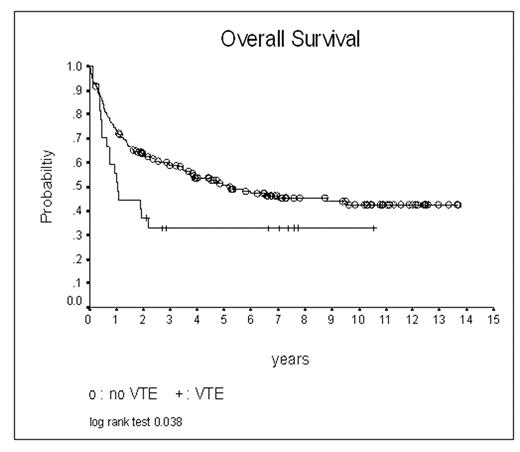Abstract
Background:
Venous thromboembolism (VTE) including deep venous thrombosis (DVT) and pulmonary embolism (PE) is a well-known complication of cancer. VTE frequency varies according to the underlying malignancy. Diffuse large B cell Lymphoma (DLBCL) is the most common type of non-Hodgkin’s lymphoma (NHL). VTE during initial treatment of DLBCL is a complication recognized by treating physicians. Little information is available regarding the frequency of VTE and its association with outcomes in DLBCL. We conducted a retrospective cohort study to determine the frequency and timing of VTE during initial treatment of DLBCL, as well as identifying risk factors associated with VTE, and the clinical impact of VTE on survival.
Methods:
We reviewed records of consecutive patients diagnosed with de novo DLBCL seen at University of Rochester from January 1990 to December 2001. Patients with transformed DLBCL, CNS lymphoma, HIV-related NHL, and patients whose complete records were unavailable were excluded. We considered only episodes of VTE that occurred during the initial treatment of DLBCL. For analysis of risk factors for VTE, Chi-square test or Fisher’s exact test was used to compare the categorical variables and t-test was used to compare continuous variables. Kaplan-Meier estimate was used to compare overall survival between patients with or without VTE. Log-rank test was used to compare statistical differences between survival curves.
Results:
A total of 211 patients with DLBCL were included. VTE occurred in 27 patients (12.8%). DVT occurred in 22, PE occurred in 3, and both DVT and PE in 2. Of all VTE, 37% occurred at diagnosis of DLBCL, and 82% in the first three cycles of treatment. VTE involved the lower limb in 44%. Baseline characteristics were similar between patients with or without VTE regarding age, sex, race, ECOG performance status, histology, B symptoms, LDH, and bone marrow involvement. Fewer patients with VTE, however, were stage I compared to the no VTE group (3.7% vs 27.3 %, P = 0.017). Furthermore, patients with VTE were more likely to be in the high-risk international prognostic index (IPI) category (29.6% vs 10.3%, P = 0.048). Median survival time for patients with VTE was 1.04 years (95% CI 0.75–1.33) compared to 5.2 years for patients with no VTE (95% CI 1.8–8.6) (Log rank test, P = 0.038).
Conclusion:
VTE is a frequent complication of initial treatment of DLBCL. The majority of cases occur at diagnosis or during the first three cycles of treatment. High-risk IPI is associated with increased incidence of VTE during initial treatment of DLBCL. VTE is a poor prognostic factor and is associated with inferior survival. Clinical trials of thromboprophylaxis are warranted.


